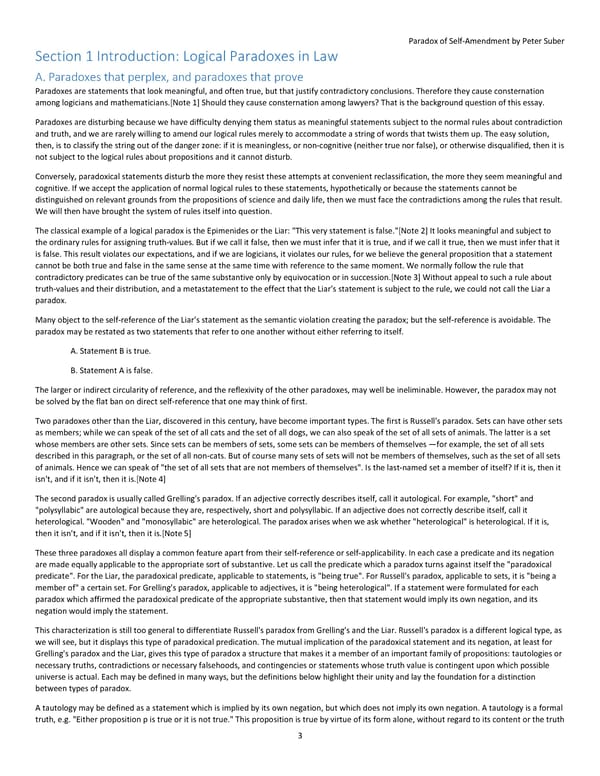Paradox of Self-Amendment by Peter Suber Section 1 Introduction: Logical Paradoxes in Law A. Paradoxes that perplex, and paradoxes that prove Paradoxes are statements that look meaningful, and often true, but that justify contradictory conclusions. Therefore they cause consternation among logicians and mathematicians.[Note 1] Should they cause consternation among lawyers? That is the background question of this essay. Paradoxes are disturbing because we have difficulty denying them status as meaningful statements subject to the normal rules about contradiction and truth, and we are rarely willing to amend our logical rules merely to accommodate a string of words that twists them up. The easy solution, then, is to classify the string out of the danger zone: if it is meaningless, or non-cognitive (neither true nor false), or otherwise disqualified, then it is not subject to the logical rules about propositions and it cannot disturb. Conversely, paradoxical statements disturb the more they resist these attempts at convenient reclassification, the more they seem meaningful and cognitive. If we accept the application of normal logical rules to these statements, hypothetically or because the statements cannot be distinguished on relevant grounds from the propositions of science and daily life, then we must face the contradictions among the rules that result. We will then have brought the system of rules itself into question. The classical example of a logical paradox is the Epimenides or the Liar: "This very statement is false."[Note 2] It looks meaningful and subject to the ordinary rules for assigning truth-values. But if we call it false, then we must infer that it is true, and if we call it true, then we must infer that it is false. This result violates our expectations, and if we are logicians, it violates our rules, for we believe the general proposition that a statement cannot be both true and false in the same sense at the same time with reference to the same moment. We normally follow the rule that contradictory predicates can be true of the same substantive only by equivocation or in succession.[Note 3] Without appeal to such a rule about truth-values and their distribution, and a metastatement to the effect that the Liar's statement is subject to the rule, we could not call the Liar a paradox. Many object to the self-reference of the Liar's statement as the semantic violation creating the paradox; but the self-reference is avoidable. The paradox may be restated as two statements that refer to one another without either referring to itself. A. Statement B is true. B. Statement A is false. The larger or indirect circularity of reference, and the reflexivity of the other paradoxes, may well be ineliminable. However, the paradox may not be solved by the flat ban on direct self-reference that one may think of first. Two paradoxes other than the Liar, discovered in this century, have become important types. The first is Russell's paradox. Sets can have other sets as members; while we can speak of the set of all cats and the set of all dogs, we can also speak of the set of all sets of animals. The latter is a set whose members are other sets. Since sets can be members of sets, some sets can be members of themselves —for example, the set of all sets described in this paragraph, or the set of all non-cats. But of course many sets of sets will not be members of themselves, such as the set of all sets of animals. Hence we can speak of "the set of all sets that are not members of themselves". Is the last-named set a member of itself? If it is, then it isn't, and if it isn't, then it is.[Note 4] The second paradox is usually called Grelling's paradox. If an adjective correctly describes itself, call it autological. For example, "short" and "polysyllabic" are autological because they are, respectively, short and polysyllabic. If an adjective does not correctly describe itself, call it heterological. "Wooden" and "monosyllabic" are heterological. The paradox arises when we ask whether "heterological" is heterological. If it is, then it isn't, and if it isn't, then it is.[Note 5] These three paradoxes all display a common feature apart from their self-reference or self-applicability. In each case a predicate and its negation are made equally applicable to the appropriate sort of substantive. Let us call the predicate which a paradox turns against itself the "paradoxical predicate". For the Liar, the paradoxical predicate, applicable to statements, is "being true". For Russell's paradox, applicable to sets, it is "being a member of" a certain set. For Grelling's paradox, applicable to adjectives, it is "being heterological". If a statement were formulated for each paradox which affirmed the paradoxical predicate of the appropriate substantive, then that statement would imply its own negation, and its negation would imply the statement. This characterization is still too general to differentiate Russell's paradox from Grelling's and the Liar. Russell's paradox is a different logical type, as we will see, but it displays this type of paradoxical predication. The mutual implication of the paradoxical statement and its negation, at least for Grelling's paradox and the Liar, gives this type of paradox a structure that makes it a member of an important family of propositions: tautologies or necessary truths, contradictions or necessary falsehoods, and contingencies or statements whose truth value is contingent upon which possible universe is actual. Each may be defined in many ways, but the definitions below highlight their unity and lay the foundation for a distinction between types of paradox. A tautology may be defined as a statement which is implied by its own negation, but which does not imply its own negation. A tautology is a formal truth, e.g. "Either proposition p is true or it is not true." This proposition is true by virtue of its form alone, without regard to its content or the truth 3
 The Paradox of Self-Amendment Page 14 Page 16
The Paradox of Self-Amendment Page 14 Page 16